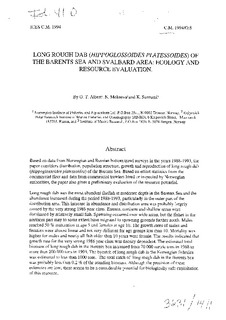| dc.contributor.author | Albert, Ole Thomas | |
| dc.contributor.author | Mokeeva, Natalia | |
| dc.contributor.author | Sunnanå, Knut | |
| dc.date.accessioned | 2012-09-13T09:18:07Z | |
| dc.date.available | 2012-09-13T09:18:07Z | |
| dc.date.issued | 1994 | |
| dc.identifier.citation | This report is not to be cited without prior reference to the authors | no_NO |
| dc.identifier.uri | http://hdl.handle.net/11250/105350 | |
| dc.description.abstract | Based on data from Norwegian and Russian bottom trawl surveys in the years 1988-1993, the
paper considers distribution, population structure, growth and reproduction of long rough dab
(Hippoglossoides platessoides) of the Barents Sea. Based on effort statistics from the
commercial fleet and data from commercial trawlers hired or inspected by Norwegian
authorities, the paper also gives a preliminary evaluation of the resource potential.
Long rough dab was the most abundant flatfish at moderate depth in the Barents Sea and the
abundance increased during the period 1988-1993, particularly in the outer part of the
distribution area. This increase in abundance and distribution area was probably largely
caused by the very strong 1986 year class. Eastern, northern and shallow areas were
dominated by relatively small fish. Spawning occurred over wide areas, but the fishes in the
northern part may to some extent have migrated to spawning grounds further south. Males
reached 50% maturation at age 5 and females at age 10. The growth rates of males and
females were almost linear and not very different for age groups less than 10. Mortality was
higher for males and nearly all fish older than 10 years were female. The results indicated that
growth rate for the very strong 1986 year class was density dependent. The estimated total
biomass of long rough dab in the Barents Sea increased from 70 000 metric tons in 1988 to
more than 200 000 tons in 1993. The bycatch of long rough dab in the Norwegian fisheries
was estimated to less than 1000 tons. The total catch of long rough dab in the Barents Sea
was probably less than 0.2 % of the standing biomass. Although the precision of these
estimates are low, there seems to be a considerable potential for biologically safe exploitation
of this resource. | no_NO |
| dc.language.iso | eng | no_NO |
| dc.publisher | ICES | no_NO |
| dc.relation.ispartofseries | ICES CM Documents;1994/O:8 | |
| dc.subject | flounder | no_NO |
| dc.subject | flyndre | no_NO |
| dc.subject | stock assessment | no_NO |
| dc.subject | bestandsberegning | no_NO |
| dc.subject | distribution | no_NO |
| dc.subject | utbredelse | no_NO |
| dc.title | Long rough dab (Hippoglossoides platessoides) of the Barents Sea and Svalbard area: ecology and resource evaluation | no_NO |
| dc.type | Working paper | no_NO |
| dc.subject.nsi | VDP::Agriculture and fishery disciplines: 900::Fisheries science: 920::Catch: 925 | no_NO |
| dc.subject.nsi | VDP::Mathematics and natural science: 400::Geosciences: 450::Oceanography: 452 | no_NO |
| dc.subject.nsi | VDP::Agriculture and fishery disciplines: 900::Fisheries science: 920::Fish health: 923 | no_NO |
| dc.source.pagenumber | 40 s. | no_NO |
